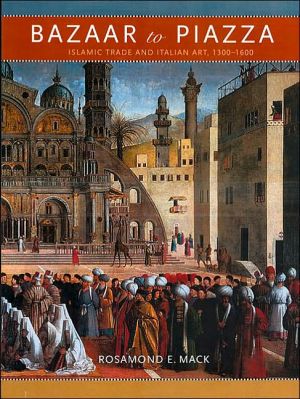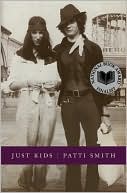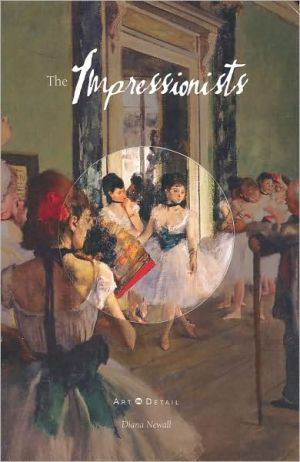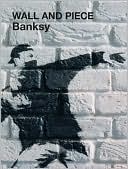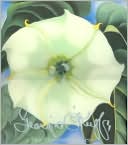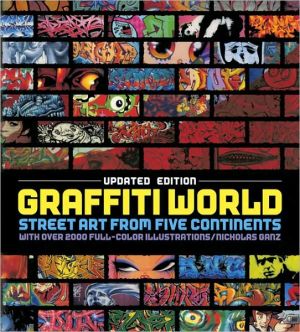Bazaar to Piazza: Islamic Trade and Italian Art, 1300-1600
The Mediterranean trade in luxury goods from the East made a strong and lasting impression on Italian artistic taste and production during the early Renaissance. This opulently illustrated book describes and illustrates the fascinating ways that imported art objects inspired improvements and new variety in Italian decorative arts. From Italian textiles featuring Islamic and Asian motifs to ceramics and glassware that reflected Syrian techniques and ornamental concepts, this book gives an...
Search in google:
"This is a book for which there is no published counterpart, and it is likely to have considerable appeal to students, collectors, and museum curators working on European or Islamic decorative arts. There have been many articles on the subjects covered by this book, but no attempt to pull so much diverse material together into a single publication."—Julian Raby, author of VeBérénice, Dürer, and the Oriental Mode"Mack's imaginatively researched and lively text explores the acquisition and interpretation of Islamic works of art in Renaissance Italy, in media such as ceramics, glass, and textiles. The book's emphasis is strongly visual; it is richly illustrated with objects of stunning design and workmanship from an impressive range of museum collections. The book will serve as a source of enduring value for the specialist, just as it will delight the avid museum-goer."—Deborah Howard, author of VeBérénice and the East: The Impact of the Islamic World on Venetian Architecture 1100-1500 "Mack's survey of luxury objects and techniques in the late Middle Ages and especially during the Renaissance is excellently researched, well written, learned and interesting at the same time. . . . The scholarship is superior, in fact quite amazing, if one considers the variety of topics involved, the illustrations plentiful but essential."—Oleg Grabar, author of The Shape of the Holy: Early Islamic Jerusalem "This manuscript traces the influence of oriental motifs, imagery and craftsmanship on Italian artists and craftsmen, offering a valuable overview of a series of complex cultural and aesthetic interchanges. I found the discussion illuminating, a fascinating read on the whole."—Patricia Fortini Brown, author of VeBérénice and Antiquity: The Venetian Sense of the Past
BAZAAR to PIAZZA\ ISLAMIC TRADE AND ITALIAN ART, 1300-1600 \ \ By ROSAMOND E. MACK \ University of California\ Copyright © 2002 Regents of the University of California\ All right reserved.\ ISBN: 0-520-22131-1 \ \ \ \ Introduction\ Really all Christendom could be supplied for a year with the merchandise of Damascus.... There are such rich and noble and delicate works of every kind that if you had money in the bone of your leg, without fail you would break it to buy of these things. -SIMONE SIGOLI, FLORENTINE PILGRIM, 1384 \ A WEALTHY FLORENTINE LIKE SIMONE SIGOLI DID NOT have to travel to the bazaars of Damascus to acquire the alluring merchandise he described, because Italian merchant galleys were bringing huge quantities to European markets. Between 1300 and 1600, the international luxury trade had a broad impact on Italian artistic taste and development, inspiring tremendous improvements and new variety in the decorative arts-textiles, ceramics, glass, leatherwork, lacquer, and brassware. Even after Italian Renaissance versions of these luxury objects attained international renown, Italians continued to collect, imitate, and adapt imported Oriental art objects.\ The imports here called Oriental came from China and from Islamic lands stretching from Spain across North Africa to Syria, Anatolia, Persia, and the vast Mongol empire in Asia. Because Islamic countries included almost three-quarters of the Mediterranean's shores, and the international luxury trade on land and sea became increasingly multidirectional, both the term "East-West" for this trade and traditional semantic distinctions between Europe (or the West) and the Orient (or the East) oversimplify. The imported art objects popular and influential in Italy during the three centuries that are the focus of this study varied considerably in origin, type, and style. Today, they are classified by their place of manufacture-often regional rather than local-and period style as well as medium. Then, however, Italians understood little about the different geographic and artistic origins of the foreign objects they admired. In the contemporary context, therefore, the term "Oriental" for all the art objects coming to the Italian market from Islamic lands and Asia continues to have some merit because of its imprecision.\ The period of this study encompasses the development of Italian Renaissance culture, in particular the fine and decorative arts, and Italy's predominance in trans-Mediterranean trade. The very paintings that revolutionized Italian art about 1300 also reflect the dynamic rise in overseas trade and travel. The Italian textile industry soon began to compete with Oriental silks, and Venetian late Gothic architectural decoration began to advertise the Republic's commercial connections in the East. During the fifteenth century, the imports inspired rapid development in various Italian craft industries. By 1600, when the role of Italy as an international carrier of luxury goods was diminishing, it had become a leading producer.\ It is no mere coincidence that Italy became an artistic superpower during its most active and profitable engagement in the international luxury trade. Western scholarship, however, has underestimated the importance of this relationship for two reasons. First, the critical evaluation of Italian Renaissance art has long focused on painting, sculpture, and architecture. Indeed, these "major arts" were the principal concern of the publication that shaped subsequent Renaissance art history, the 1568 edition of The Lives of the Most Famous Italian Painters, Sculptors, and Architects by the Tuscan painter and architect Giorgio Vasari. He based his theory of continual progress in Italy's visual arts from about 1300 to their peak in his own time on a return to nature and the classical tradition inherited from ancient Rome, emphasizing native artistic genius and sources of inspiration. Vasari knew of both developments in the decorative arts and foreign styles. For example, he sincerely admired inlaid brassware decorated with arabesques made "in Damascus and all over the Levant," rightly crediting it with inspiring recent improvements in Italian metalwork. Undoubtedly because the influence of Islamic metalwork was inconsistent with his theory about the sources of Italian Renaissance art, he disingenuously called the technique antique.\ Second, developments in Italy's various decorative arts have rarely been viewed collectively. Specialized studies have identified numerous instances of Islamic and Asian influence. But a true measure of how many foreign, Oriental objects, techniques, and styles of decoration were absorbed into Italian crafts during the three crucial centuries of their development requires a synthetic approach. In addition, to assess the period's transcultural artistic exchange overall, the decorative arts should be considered alongside paintings, sculptures, and architecture that reflect Oriental trade and travel. Such is the approach undertaken in this study.\ The one characteristic common to the various popular and influential Oriental objects was their portable size, which meant they could arrive in quantity and spread widely. Ceramics that were mediocre by Islamic standards were long admired throughout Italy and had a significant impact on Italian pottery. The Cathedral of San Miniato near Pisa (Fig. 1), built at the end of the twelfth century, epitomizes the many late-tenth- to early-fourteenth-century church facades and towers in Italy that are decorated with the Islamic earthenware bowls commonly called bacini. On this facade, only the shadowed recesses left when the bacini were removed show their original location. Most of these bacini now in the Museo Nazionale di San Matteo, Pisa, are crudely painted with traditional Islamic animal, plant, and geometric motifs (Fig. 2) and stylized Arabic script in brown and blue over an opaque white tin glaze. They probably came from North Africa: many sherds comparable in design and technique have been excavated in Carthage, a suburb of Tunis, where Pisa had strong trading connections. Excavations in Pisa indicate that such bowls arrived in large quantities and were used as kitchenware. Most of the bacini elsewhere in Italy are also humble objects that probably arrived by ordinary commerce. They contributed color and sheen to brick facades-more cheaply than the marble and mosaic inlay popular in contemporary Italian Romanesque architecture. The importation and use of the bacini, in addition to demonstrating the diffusion of Islamic domestic utensils during the late Middle Ages, show that Italians appreciated their aesthetic qualities and were quick to employ them ornamentally, even in their most important religious buildings. Among the early bacini are a few high-quality Egyptian or Syrian vessels that may have been brought back from the Holy Land or Constantinople by crusaders and other travelers, who donated them to local institutions and building projects, in which case the origin may have been significant. The bacini inspired local imitations (see Fig. 89) and widespread improvements in Italian pottery.\ In contrast, two exceptional examples of monumental Oriental art seized during the late Middle Ages and publicly displayed thereafter had no artistic influence. The superb Pisa Griffin (Fig. 3), the largest surviving example of Islamic bronze sculpture, was probably brought back from one of Pisa's many conquests on western Mediterranean Muslim shores during the late eleventh and early twelfth century. The griffin was soon installed on a gable atop the new cathedral of Pisa, which was begun in 1064, and remained there until 1828; it is now in the Museo dell'Opera del Duomo. Inscriptions on the cathedral's facade commemorate the victories that had yielded booty to finance its construction as well as the city's commercial advantages and Christian honor. But the griffin as a victory trophy was raised too high above the public eye for its artistry to be appreciated. The Lion of Venice, a rare antique bronze rendition of a fantastic Oriental beast, probably came from the eastern Mediterranean. From at least 1293 to 1985, it crowned a huge monolithic column at the quayside entrance to the Piazza San Marco in Venice, the city's ceremonial gateway (see Fig. 10). Though the lion originally had wings, technical analysis indicates that they no longer existed when Venetians acquired the statue and transformed it into a symbol of Saint Mark, the patron saint of the Republic, by adding new wings and a book beneath one of its forepaws. Although a winged Lion of Saint Mark eventually became the city's emblem, Venetian images of the emblematic lion (see, for example, Fig. 143) were never modeled on the statue, which was approximated only in representations of the piazza with its landmarks.\ As historians of Islamic art emphasize, several characteristics of small Islamic objects contributed to their acceptance and influence in Europe. First of all, they were secular, utilitarian articles, technically and artistically superior to what was being produced in Europe. During the ninth century, under the Abbasid caliphs in Baghdad, the Muslim elite had developed a rich urban culture that valued grace and pleasure in everyday life. Major developments in silk weaving, ceramics, metalwork, and wood carving transformed common articles of daily use into works of art. The colorful hangings, cushions, and rugs that traditionally furnished the tent of the nomad were now woven in fine designs of luxurious, sensuous materials. Clothing also became rich and elegant. Bowls, plates, jugs, and lamps were given visual and tactile qualities that added excitement to their use. Elaborate burners and pierced containers were crafted to enhance the enjoyment of costly aromatics. Writing assumed shapes and rhythms to delight even eyes that could not read its meaning. The culture of the Baghdad elite was emulated throughout the Islamic world, and from the ninth to the end of the sixteenth century the objects that were its hallmark were imported, imitated, and further developed by Muslim artists and artisans from Spain to China. These beautiful objects for personal and domestic use began to arrive in quantity in Europe during the Crusades, when the feudal nobility and rising urban bourgeoisie had both the means and the desire to live more comfortably and ostentatiously. The growing wealth of the European elite during the fourteenth and fifteenth centuries created a huge demand for luxury imports, gradually encouraging the development of competitive local products. Even the modest bacini, for example, were superior to central and northern Italian ceramics until the fourteenth century, and Italian potters could not match the artistic quality of fine Syrian and Spanish wares until the late fifteenth century. Admiration for Chinese porcelain vessels, which were superior to all earthenware, was international. Though their material could not be replicated, their distinctive decoration was imitated in the Islamic world from about 1400, and in Italy from about 1500.\ A second characteristic that increased the popularity of Oriental objects was their decoration. Because of the Muslim ban on idolatry, they bore no overt religious representations or symbols to o end Christian eyes. The human figures appearing on medieval Islamic metalwork, ceramics, and glassware (see Fig. 124) are almost always engaged in the princely pleasures of drinking, music making, riding, or hunting, some of which the European feudal nobility pursued. The ornate Arabic script on many Islamic objects was intended primarily to give visual delight and to convey an association with the faith and community of believers rather than a literal meaning (see, for example, Fig. 3). Europeans as well as Muslims unable to read Arabic inscriptions could admire their beautiful calligraphy. All cultures can enjoy the geometric, plant, and animal ornament that predominates in Islamic art.\ Moreover, because European and Islamic cultures of the Mediterranean shared a common Greco-Roman and Byzantine artistic heritage, the organization of Islamic ornament was often familiar to the European eye. A large drug jar (Fig. 4) exemplifies the Spanish pottery that Italians imported in huge quantities during the fifteenth century. The foreign elements are the graceful tapered shape, common in Islamic containers, called albarelli in Italy, that were used to ship and store costly spices and the painted decoration of stylized ivy and fern leaves in cobalt blue and golden metallic luster, characteristic of the Hispano-Moresque wares of Valencia. Both the balanced alternation of blue and luster in the ivy leaves and the clear composition of the plant scrolls in horizontal bands that harmonize with, and complement the shape of, the jar suited contemporary Italian aesthetic tastes. Though Vasari certainly considered the intricate arabesque motifs on popular imported metalwork "Levantine" art forms (see Fig. 151), he could have found nothing alien in the organization of surface ornament: the clear outlining of major forms and divisions in silver and their balanced, mathematically regular repetition. Italian Renaissance and Islamic art both emphasize harmony of design, balance of parts, and perfection of the whole composition. The basic difference is that European art retained the naturalistic and representational bias of the Greco-Roman tradition, whereas Islamic art is fundamentally ornamental. In Gothic and Renaissance art, plants or animals used as decorative motifs increasingly look and grow or behave as they do in nature, and decoration usually frames, fills, or links representation, which is foremost in the composition and bears most of the meaning. The ornamentation covering the surface of influential Oriental imports was intended to please the senses and to enhance the object. Because this decoration was, or could be perceived as, nondidactic and had a recognizable organizing structure, Europeans could readily appreciate and adapt its artistry.\ Specific religious or social meanings that some objects had in their Muslim context were lost as Europeans employed them in their own secular or Christian practices or displayed them as precious works of art. Egyptian and Syrian ewers and basins, originally made for ritual hand washing before prayers and meals, could contain the wine of the Eucharist, as on the bronze pulpits by Donatello's workshop in San Lorenzo, Florence, of the mid-1460s, or be presented at childbirth, as in Paolo di Giovanni Fei's Birth of the Virgin Mary of the 1380s (see Fig. 42). An inlaid brass bucket that an Egyptian or Syrian might have carried to the community bathhouse held holy water in northern Italy (see Fig. 148). Silk brocades with prominent Arabic inscriptions praising Mamluk sultans, originally worn as signs of status and allegiance, were sewn into ecclesiastical vestments throughout Europe. For example, the inscriptions on a dalmatic made about 1350-1400 read "the sultan the wise" and "the sultan" (see Fig. 32).\ \ Continues...\ \ \ \ Excerpted from BAZAAR to PIAZZA by ROSAMOND E. MACK Copyright © 2002 by Regents of the University of California. Excerpted by permission.\ All rights reserved. No part of this excerpt may be reproduced or reprinted without permission in writing from the publisher.\ Excerpts are provided by Dial-A-Book Inc. solely for the personal use of visitors to this web site. \ \
Preface and Acknowledgments Introduction1. Trade, Travel and Diplomacy2. Patterned Silks3. Oriental Script in Italian Paintings4. Carpets5. Ceramics6. Glass7. Bookbinding and Lacquer8. Inlaid Brass9. The Pictorial Arts10. From Bazaar to Piazza and BackNotes Glossary Bibliography Picture Credits Index
